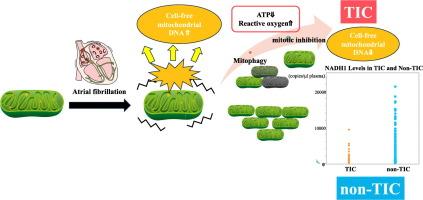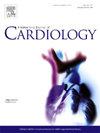血浆细胞游离线粒体 DNA 的减少可能是心房颤动患者心动过速诱发心肌病的新生物标志物。
IF 3.2
2区 医学
Q2 CARDIAC & CARDIOVASCULAR SYSTEMS
引用次数: 0
摘要
目的确定心动过速诱发的心肌病(TIC)和心房颤动(AF)病例中的无细胞线粒体 DNA(mt-cfDNA)水平:背景:TIC 是由房颤等快速性心律失常引起的一种可逆性心肌病。TIC 的确切病因尚不完全清楚,但据报道,线粒体功能障碍可导致多种心肌病,TIC 也可能与线粒体功能障碍有关。房颤被认为与全身炎症有关,研究表明,房颤患者的线粒体-cfDNA水平升高,而这种升高与全身炎症有关:我们选取了 2009 年 11 月至 2016 年 9 月期间在我院接受房颤导管消融术且不符合排除标准的 67 例 TIC 患者(TIC 组)和 671 例无 TIC 患者(非 TIC 组)。我们对血浆mt-cfDNA和核-cfDNA进行了定量PCR分析,并比较了两组患者的临床因素和这些测量结果:结果:TIC 组的 mt-cfDNA 水平明显低于非 TIC 组(1110.01 对 1918.71 拷贝/μg 血浆,P = 0.027),而这两组的核 cfDNA 水平相当。缩写摘要:心动过速诱发的心肌病(TIC)是由心动过速引起的可逆性心肌病,如心房颤动性心动过速。人们对 TIC 的发病机理尚不完全清楚,目前也没有方法预测患者的发病情况。在这项研究中,我们发现 TIC 组的细胞游离线粒体 DNA(mt-cfDNA)水平明显低于非 TIC 组。持续房颤、并存糖尿病和 mt-cfDNA 水平降低与 TIC 有独立关联。mt-cfDNA水平的降低可作为预测房颤患者TIC的新型生物标志物。本文章由计算机程序翻译,如有差异,请以英文原文为准。

Decreased plasma cell-free mitochondrial DNA may be a new biomarker of tachycardia-induced cardiomyopathy in patients with atrial fibrillation
Objectives
To determine cell-free mitochondrial DNA (mt-cfDNA) levels in tachycardia-induced cardiomyopathy (TIC) and non-TIC among atrial fibrillation (AF) cases.
Backgrounds
TIC is a reversible cardiomyopathy resulting from tachyarrhythmias, such as AF. The exact cause of TIC is not fully understood, but mitochondrial dysfunction has been reported in a variety of cardiomyopathies and may be involved in TIC as well. AF is recognized to be associated with systemic inflammation, and studies have shown that in patients with AF have elevated levels of mt-cfDNA increased, and this increase is linked to systemic inflammation.
Methods
We enrolled 67 patients with TIC (TIC group) and 671 patients without TIC (non-TIC group), who underwent catheter ablation for AF at our hospital between November 2009 and September 2016 and did not meet the exclusion criteria. We performed quantitative PCR analysis of plasma mt-cfDNA and nuclear-cfDNA and compared clinical factors and these measurements between the two groups.
Results
Levels of mt-cfDNA were significantly lower in the TIC group than in the non-TIC group (1110.01 vs. 1918.71 copies/μg plasma, P = 0.027), while levels of nuclear-cfDNA were comparable between these two groups. In particular, mt-cfDNA (P = 0.0003, odds ratio [OR] 2.54), non-paroxysmal AF (P < 0.0001, OR 3.07), and diabetes mellitus (P = 0.006, OR 2.36) were identified as independent factors associated with TIC.
Conclusion
There are lower mt-cfDNA in TIC, and decreased plasma levels of circulating mt-cfDNA may be a new biomarker and involve in related mechanisms for AF associated TIC.
Condensed abstract
Tachycardia-induced cardiomyopathy (TIC) is a reversible cardiomyopathy caused by tachyarrhythmias, such as atrial fibrillation (AF) tachycardia. The pathogenesis of TIC remains incompletely understood, and there is currently no method to predict its development in patients. In this study, we show that cell-free mitochondrial DNA (mt-cfDNA) levels were significantly lower in the TIC group than in the non-TIC group. Persistent AF, coexisting diabetes mellitus, and decreased mt-cfDNA levels were independently associated with TIC. Decreased mt-cfDNA levels may serve as a novel biomarker for predicting TIC in patients with AF.
求助全文
通过发布文献求助,成功后即可免费获取论文全文。
去求助
来源期刊

International journal of cardiology
医学-心血管系统
CiteScore
6.80
自引率
5.70%
发文量
758
审稿时长
44 days
期刊介绍:
The International Journal of Cardiology is devoted to cardiology in the broadest sense. Both basic research and clinical papers can be submitted. The journal serves the interest of both practicing clinicians and researchers.
In addition to original papers, we are launching a range of new manuscript types, including Consensus and Position Papers, Systematic Reviews, Meta-analyses, and Short communications. Case reports are no longer acceptable. Controversial techniques, issues on health policy and social medicine are discussed and serve as useful tools for encouraging debate.
 求助内容:
求助内容: 应助结果提醒方式:
应助结果提醒方式:


